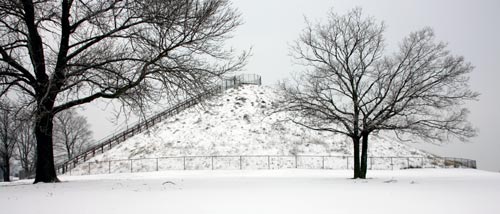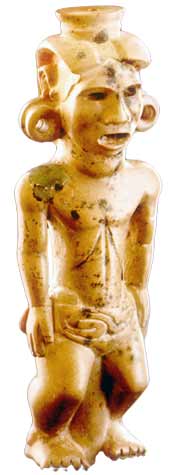Story Mound -- located in Chillicothe stood over 19 feet tall and was about 95 feet in diameter
Adena Culture: Mound Builders
The Adena Culture was a name given to the people who built the first burial mounds in Ohio. The first of these burial mounds to be excavated was on the property of Thomas Worthington's home Adena, in Chillicothe. While this particular mound was made by the Adena Culture, it is not to suggest that this was their first mound. The Adena Culture was wide spread from Indiana to New York and from central Ohio south to Kentucky, but southern Ohio seems to be the center of their culture simply because of the size and number of mounds found here.
The Adena Culture was made up of both hunters and gatherers, but they were also Ohio's first farmers. Archeological evidence suggests that they were growing sunflowers, squash, as well as a few other plants. They also created clay pots used for cooking and storage. But their main distinction was in how they buried elite members of their clan.
These mounds, some of which were quite large (see the Miamisburg Mound located south of Dayton). In the illustration below, we can see through archeological excavations, how these massive mounds were created.

Photo of display at Serpent Mound Museum
They would begin with the burial of one noted individual, perhaps the leader of the clan. As time passed, and more celebrities died, they added their remains to the mound. Not everyone was buried in this way, but only a select few. It is not clear from current studies how they handled the deaths and burials of the common people. Previous excavations in and around the larger mound groups suggest that perhaps most of the dead were handled by cremating the remains.

Large burial mound known as the Miamisburg Mound, located along the Miami River. Miamisburg Mound located south of Dayton is the tallest conical mound in Ohio.
It is also possible that the groups of mounds found in central locations such as the Mound City Group in Chillicothe, were central burial locations for multiple clans or groups of people that came there specifically to bury their honored dead.
From artifacts unearthed at these sites, it appears that the Adena people travelled far and wide across the country. Although their mounds were constructed in a relatively small geographic region in North America, items found in some of these mounds came from 1000s of miles away.
The Adena Culture appears to be the first ancient people in Ohio to create burial mounds for their honored dead. Most of what we know about this culture comes from examining what was buried with the dead.
There has been little recovered evidence of what daily life was like in the Adena Culture, but there has been extensive speculation. The Hopewell Culture which followed the Adena Culture, also built ceremonial grave mounds, but they added geometric earthworks to their population centers..
Adena Mound and Pipe
The first Adena Mound to be officially excavated was in 1901. In that one mound, archeologists found 36 human remains, most of whom were adult males. Some of the adult males were buried with 2 - 3 children.
At the very bottom of the mound was a gravel lined pit where the first dignitary was laid to rest. When the site was excavated in 1901, many of the artifacts were removed. More than a 100 years after that excavation, thanks to private donations, a radiocarbon dating test was performed on some bark found inside the mound at the very center.
Tree bark is a better indicator of when the tree was actually cut down. Since trees can live 100s of years, a precise carbon date cannot be established because it would depend on the age of the tree. Bark however, is relatively short-lived in the life of the tree. It is replaced frequently in tree growth and makes for a better indicator of when the mound was first created.
In the case of the Adena Mound found on Thomas Worthington's farm several items were radiocarbon dated. A small piece of bark and some clothing fragments were analyzed. The clothing was dated to 140 B.C. The tree bark was dated to between 100 B.C. to 40 A.D. providing us with a fairly exact time period of when this particular mound was begun.
Adena Mound construction begins with the burial of one individual, presumably a noted leader. Over the years and succeeding generations, more burials are added to the mound, making it larger and larger. This particular mound was about 26 feet tall.
 In the original burial site of the Adena Mound, an intact Adena Pipe was found. It is about 8" in length, weighs about a pound and was found next to the left hand of the body. The pipe was made from a rather soft substance known as pipestone. The artifact has a hole extending the entire length and exits through the figure's head. While many Adena pipes have been unearthed, this is the only pipe shaped in human form.
In the original burial site of the Adena Mound, an intact Adena Pipe was found. It is about 8" in length, weighs about a pound and was found next to the left hand of the body. The pipe was made from a rather soft substance known as pipestone. The artifact has a hole extending the entire length and exits through the figure's head. While many Adena pipes have been unearthed, this is the only pipe shaped in human form.
Most of the pipes recovered are in the shapes of birds, animals, and reptiles. In the burial earth surround some bodies, there would be 100s of these pipes, all broken in half before being covered over with dirt.
The pipes were carved from a special stone called "pipestone" (catlinite). Recent technology improvements have made it possible to identify where this stone came from. While some mounds have pipes made from nearby pipestone quarries, other pipes found in mounds came from a quarry in Illinois.
The Adena Pipe recently became Ohio's official artifact. That fact and the fact this one ancient artifact is the earliest piece of evidence of what this ancient culture may have looked like.
The Adena Pipe is on display at the Ohio Historical Society in Columbus.



